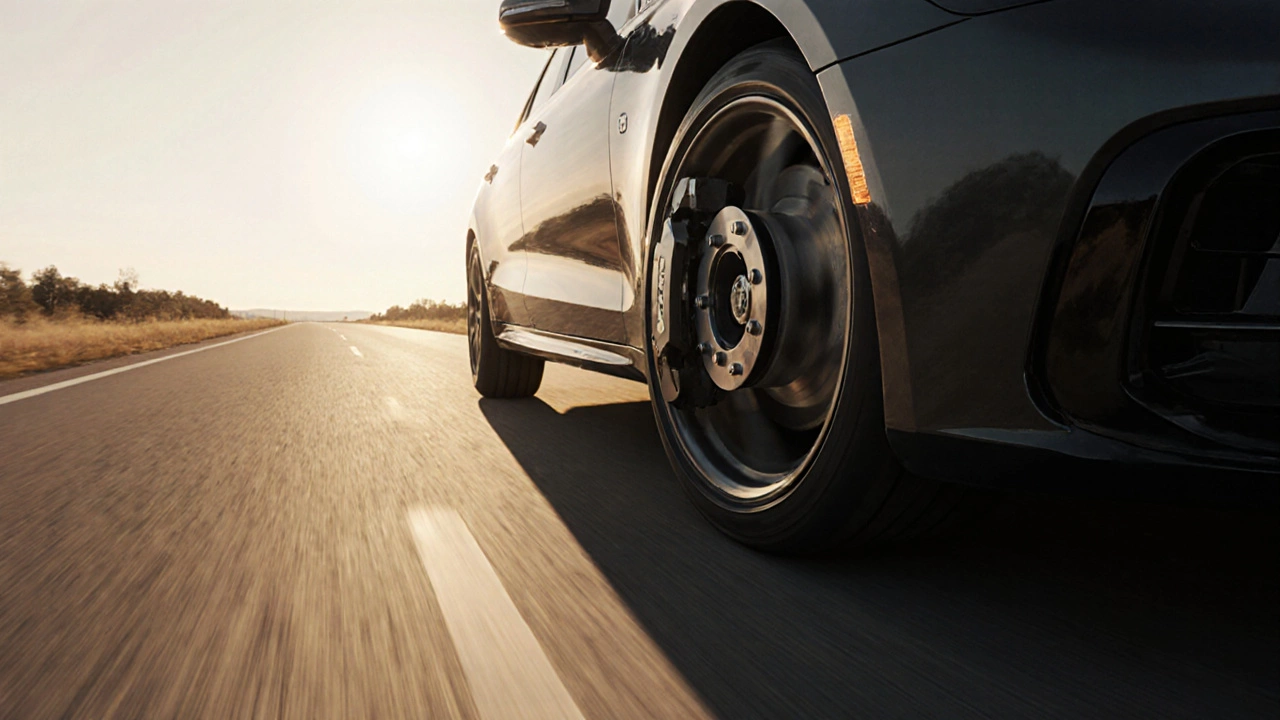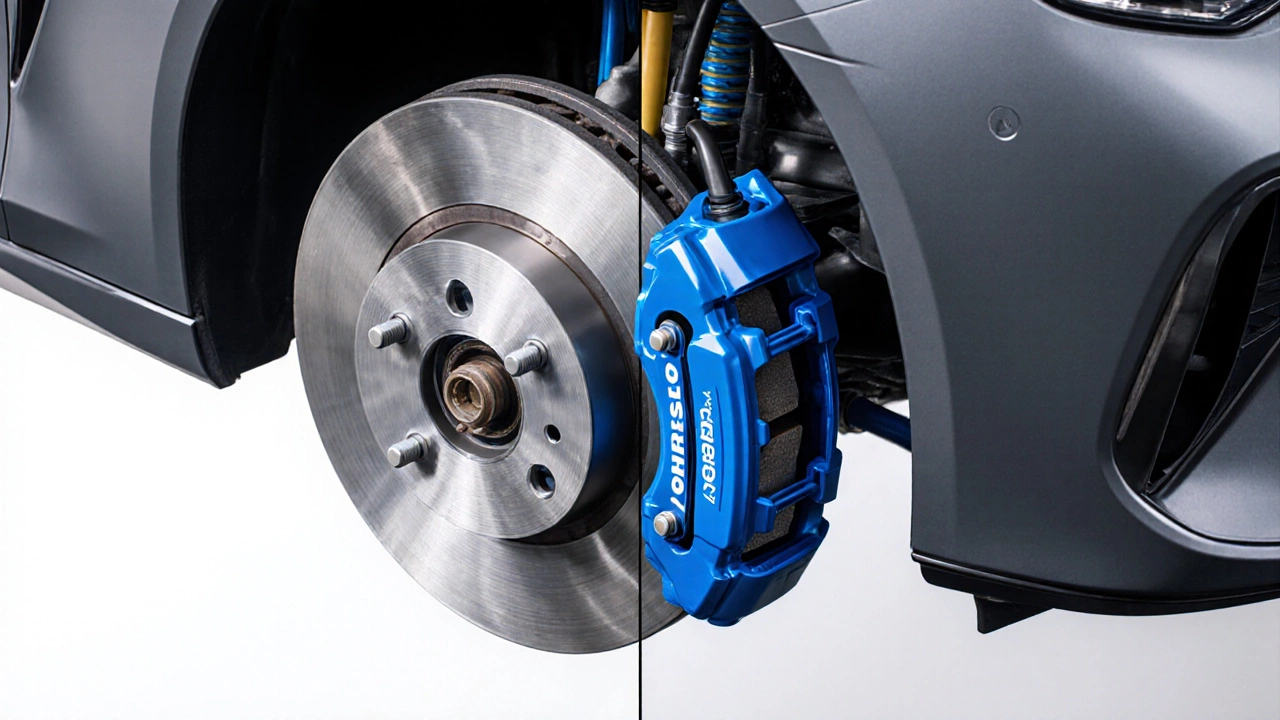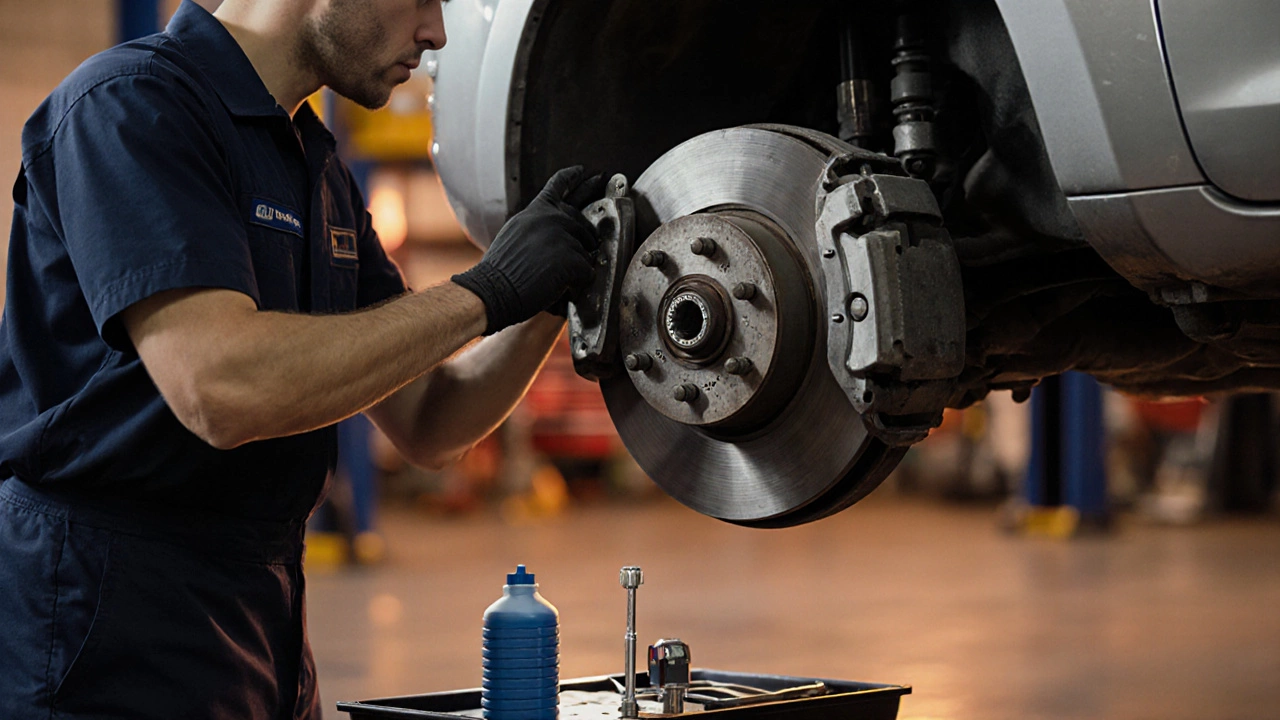 Oct, 17 2025
Oct, 17 2025
Brake Wear Estimator
Estimate when you'll need to replace front and rear brake pads based on your vehicle type and driving habits.
Front Brakes
Estimated time until replacement:
Rear Brakes
Estimated time until replacement:
When you slam on the pedal, you instinctively think all the brakes work together, but the reality is a bit more nuanced. Understanding which axle does the most work helps you drive safer, keep your tires and pads happier, and avoid costly repairs. Below we break down the physics, everyday scenarios, and maintenance tips so you can answer the age‑old question - are front brakes more important than rear brakes?
How a brake system actually works
Brake system is a collection of components that converts hydraulic pressure into friction at the wheels, slowing the vehicle down. The core players are the master cylinder, brake lines, calipers (or wheel cylinders), and the friction material - usually Brake pads replaceable friction blocks that press against a rotating disc or drum to create stopping force. Modern cars also add electronic aids like ABS anti‑lock braking system that prevents wheel lock‑up during hard stops to keep steering control.
Front vs rear: what’s the job?
Both axles have the same basic job - create friction - but they do it in different ways. Front brakes are typically larger, use disc rotors and do the bulk of the stopping work. They are larger because the front of a car carries more weight, especially during braking when weight shifts forward (called weight transfer the movement of the vehicle’s mass toward the front wheels when you decelerate).
On the flip side, Rear brakes are often smaller, may use disc or drum designs, and primarily stabilize the car. Their job is to keep the rear wheels from sliding out of line, which is essential for cornering stability and preventing spin‑outs.
Why front brakes usually do more work
Statistically, front brakes contribute roughly 60‑70% of a vehicle’s total stopping power. Here’s why:
- Weight shift: During a hard stop, up to 70% of the car’s mass can move onto the front axle, increasing the grip available to the front tires.
- Larger rotors: Front discs are often 300‑320mm in diameter compared to 260‑280mm rear rotors, giving a bigger leverage arm for torque conversion.
- More aggressive pad compounds: Manufacturers pair front pads with higher‑temperature‑resistant formulas because the front brakes heat up faster.
If you ever notice the front pads wearing down faster than the rear, that’s a normal sign of the front doing the heavy lifting.
When rear brakes matter more
Even though front brakes dominate, rear brakes are not just decorative. Certain situations demand more rear effort:
- Heavy‑load vehicles: Trucks and SUVs with a rear‑ward weight bias (e.g., loading a trailer) rely more on rear brakes.
- Wet or icy roads: A balanced brake bias helps prevent the front wheels from locking first, which can lead to a loss of steering.
- Performance driving: Race cars often use a rear‑biased setup to induce controlled oversteer, especially when drifting.
In these cases, a well‑tuned brake bias the proportion of braking force sent to the front versus the rear wheels is crucial for safety and handling.

Balancing front and rear brake bias
Most modern vehicles come with a factory‑set bias, typically around 70% front / 30% rear. However, manufacturers also give you tools to tweak it:
- Proportioning valve: A hydraulic device that reduces pressure to the rear circuit under heavy braking.
- Electronic brake‑force distribution (EBD): An ECU‑controlled system that adjusts bias on the fly based on load, speed, and slip.
- Manual adjustments: Some performance cars let you swap proportioning valves or install adjustable ones.
For everyday drivers, the best practice is to let the factory setup do its job and focus on keeping the pads, rotors, and fluid in good shape.
Maintenance tips for front and rear brakes
Even though front pads wear faster, both axles need regular attention. Here’s a quick checklist:
- Inspect front brake pads every 10,000mi; replace when thickness hits 3mm.
- Check rear brake pads at the same interval, but you may get up to 20,000mi before they need swapping.
- Measure rotor thickness; front rotors often run out of material sooner due to heat.
- Look for uneven wear - a sign the bias is off or a caliper is sticking.
- Flush brake fluid every 2years to avoid moisture buildup, which can cause brake fade loss of braking power due to overheating or fluid contamination.
When you replace pads, match the compound to the rotor type (disc vs drum) and driving style. Street drivers usually stick with medium‑performance pads, while track enthusiasts may opt for high‑temperature ceramic blends.
Common myths busted
Myth 1: Rear brakes aren’t necessary. False. Even a tiny rear braking force improves stability and reduces stopping distance by up to 5% on slippery surfaces.
Myth 2: Bigger rotors always mean better brakes. Not always. Rotor size must match caliper piston area and pad material; an oversized rotor on a weak caliper won’t help.
Myth 3: If one side squeals, only that side needs attention. Often a squeal on the front indicates a worn pad, but it can also be a sign of a stuck caliper on the opposite side.

Quick checklist - front vs rear brake health
| Aspect | Front Brakes | Rear Brakes |
|---|---|---|
| Typical contribution to stopping | 60‑70% | 30‑40% |
| Rotor size (average) | 300‑320mm | 260‑280mm |
| Pad wear rate | Faster (replace ~10kmi) | Slower (replace ~20kmi) |
| Primary role | Generate most braking force | Stabilize & prevent wheel lock‑up |
| Common issues | Overheating, pad glazing | Sticking caliper, uneven wear |
What to do if you suspect a problem
Feeling a pull to one side when you brake? That usually means the front and rear are not sharing force evenly. Here’s a troubleshooting flow:
- Check pad thickness on both axles.
- Spin each wheel; listen for grinding or wobble.
- Inspect brake fluid level; low fluid can cause uneven pressure.
- If the issue persists, have a technician test the proportioning valve or EBD sensor.
Addressing the issue early prevents premature wear and keeps your stopping distances consistent.
Frequently Asked Questions
Do rear brakes wear out faster than front brakes?
Usually not. Because front brakes do most of the work, their pads and rotors tend to wear faster. Rear components often last twice as long under normal driving conditions.
Can I replace front and rear pads at the same time?
Yes, and it’s often recommended. Swapping both sets together ensures balanced braking performance and saves on future labor costs.
Is disc brake always better than drum brake?
Disc brakes offer better heat dissipation and more consistent performance, especially in wet conditions. However, drum brakes are still common on rear axles of many economy cars because they’re cheaper and provide adequate stopping power for lighter loads.
How does ABS affect front vs rear braking?
ABS modulates pressure on each wheel independently. It can pull a little more braking force from the rear wheels during a hard stop to keep the car steerable, effectively tweaking the bias in real time.
What is the ideal brake fluid replacement interval?
Most manufacturers suggest changing brake fluid every 24months or 30,000miles, whichever comes first, to prevent moisture buildup that can cause brake fade.